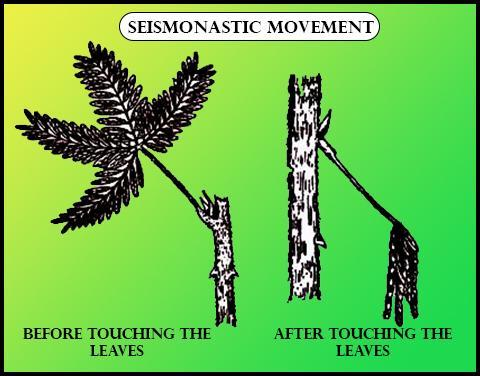
Touch me not plant shows ________ movement.
(a) Seismonastic
(b) Hyponastic
(c) Epinastic
(d) Photonastic
Answer
583.2k+ views
Hint: These movements are brought about by the mechanical stimulus, such as contact with a foreign body, fast wind, and raindrops, etc. It can be observed in stigmas, stamens, and leaves of many plants.
Complete answer:
body, fast wind, and raindrops, etc. It can be observed in stigmas, stamens, and leaves of many plants.
‘Touch me not’ plant shows seismonastic movement. The ‘touch me not’ plant (Mimosa pudica) is well known for its rapid plant movement. It undergoes changes in the orientation of leaf termed "sleep" or nyctinastic movement. The foliage (leaves) closes during the darkness and reopens in the light. The leaves also close under other stimulations as well, such as touching, warming, blowing, or shaking. These types of movements are thus termed as seismonastic movements.
Mechanism: The movement occurs when the specific regions of cells lose turgor pressure, which is the force that is applied onto the cell wall by water within the cell vacuoles and other cell contents. When the plant is disturbed, the specific regions on the stems are stimulated to release chemicals including the potassium ions. It forces water out of the cell vacuoles, the water diffuses out of the cells, producing a loss of cell pressure, and the cell collapses. Thus, the difference in turgidity between different regions of cells results in the closing of the leaflets and the collapse of the leaf petiole.

So, the correct answer is, ‘Seismonastic.’
Additional Information:
- Other plants that show seismonastic movement are Biophytum sensitivum and Neptunia oleracea.
- Smaller plants and naked protoplasmic bodies show movements of locomotion whereas the higher plants, being fixed in a position, show movements of their parts.
Note: The extent of the seismonastic movement depends upon factors such as the intensity of the stimulus, the vigor, and age of the plant, and the time elapsed since the last stimulus.
Complete answer:
body, fast wind, and raindrops, etc. It can be observed in stigmas, stamens, and leaves of many plants.
‘Touch me not’ plant shows seismonastic movement. The ‘touch me not’ plant (Mimosa pudica) is well known for its rapid plant movement. It undergoes changes in the orientation of leaf termed "sleep" or nyctinastic movement. The foliage (leaves) closes during the darkness and reopens in the light. The leaves also close under other stimulations as well, such as touching, warming, blowing, or shaking. These types of movements are thus termed as seismonastic movements.
Mechanism: The movement occurs when the specific regions of cells lose turgor pressure, which is the force that is applied onto the cell wall by water within the cell vacuoles and other cell contents. When the plant is disturbed, the specific regions on the stems are stimulated to release chemicals including the potassium ions. It forces water out of the cell vacuoles, the water diffuses out of the cells, producing a loss of cell pressure, and the cell collapses. Thus, the difference in turgidity between different regions of cells results in the closing of the leaflets and the collapse of the leaf petiole.

So, the correct answer is, ‘Seismonastic.’
Additional Information:
- Other plants that show seismonastic movement are Biophytum sensitivum and Neptunia oleracea.
- Smaller plants and naked protoplasmic bodies show movements of locomotion whereas the higher plants, being fixed in a position, show movements of their parts.
Note: The extent of the seismonastic movement depends upon factors such as the intensity of the stimulus, the vigor, and age of the plant, and the time elapsed since the last stimulus.
Recently Updated Pages
The number of solutions in x in 02pi for which sqrt class 12 maths CBSE

Write any two methods of preparation of phenol Give class 12 chemistry CBSE

Differentiate between action potential and resting class 12 biology CBSE

Two plane mirrors arranged at right angles to each class 12 physics CBSE

Which of the following molecules is are chiral A I class 12 chemistry CBSE

Name different types of neurons and give one function class 12 biology CBSE

Trending doubts
One Metric ton is equal to kg A 10000 B 1000 C 100 class 11 physics CBSE

What is 1s 2s 2p 3s 3p class 11 chemistry CBSE

Discuss the various forms of bacteria class 11 biology CBSE

State the laws of reflection of light

Explain zero factorial class 11 maths CBSE

An example of chemosynthetic bacteria is A E coli B class 11 biology CBSE




